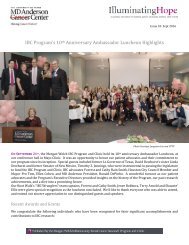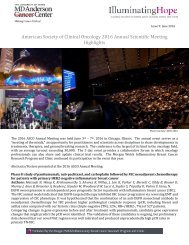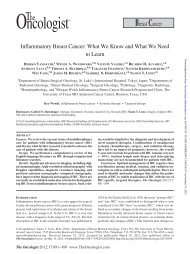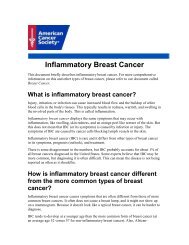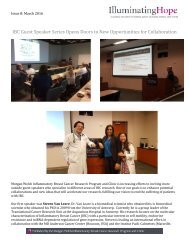Breast Cancer whole genome sequences-Nature May 2016
Create successful ePaper yourself
Turn your PDF publications into a flip-book with our unique Google optimized e-Paper software.
RESEARCH<br />
ARTICLE<br />
a<br />
80,000<br />
5,000<br />
1,200<br />
Substitutions<br />
Indels<br />
Rearrangements<br />
* *<br />
Figure 1 | Cohort and catalogue of somatic mutations in 560 breast<br />
cancers. a, Catalogue of base substitutions, insertions/deletions,<br />
rearrangements and driver mutations in 560 breast cancers (sorted by<br />
total substitution burden). Indel axis limited to 5,000(*). b, Complete list<br />
of curated driver genes sorted by frequency (descending). Fraction of ERpositive<br />
(left, total 366) and ER-negative (right, total 194) samples carrying<br />
a mutation in the relevant driver gene presented in grey. log 10 P value of<br />
enrichment of each driver gene towards the ER-positive or ER-negative<br />
cohort is provided in black. Highlighted in green are genes for which there<br />
is new or further evidence supporting these as novel breast cancer genes.<br />
b<br />
20<br />
Fraction of samples<br />
with driver<br />
100 80<br />
60<br />
ER positive<br />
Driver mutations<br />
40<br />
20<br />
0<br />
ER positive<br />
Enrichment<br />
log P value<br />
–10<br />
TP53<br />
PIK3CA<br />
MYC<br />
CCND1<br />
PTEN<br />
ERBB2<br />
ZNF703/FGFR1<br />
GATA3<br />
RB1<br />
MAP3K1<br />
MAP2K4<br />
ZNF217<br />
CDH1<br />
MLL3<br />
ARID1B<br />
CDKN2A<br />
MLLT4<br />
AKT1<br />
FBXW7<br />
ARID1A<br />
CCND3<br />
CBFB<br />
MDM2<br />
CCNE1<br />
CDKN2B<br />
NCOR1<br />
SF3B1<br />
SPEN<br />
TBX3<br />
IGF1R<br />
BRCA2<br />
NF1<br />
PIK3R1<br />
EGFR<br />
KRAS<br />
ESR1<br />
FOXA1<br />
MED23<br />
CDK6<br />
NOTCH2<br />
AKT2<br />
BRCA1<br />
CTCF<br />
KDM6A<br />
SETD2<br />
CREBBP<br />
DNMT3A<br />
FOXP1<br />
MLL2<br />
RUNX1<br />
USP9X<br />
XBP1<br />
PDGFRA<br />
ATR<br />
ERBB3<br />
FGFR2<br />
PALB2<br />
RHOA<br />
SMAD4<br />
ATM<br />
ATRX<br />
AXIN1<br />
BCOR<br />
CDKN1B<br />
CUX1<br />
GNAS<br />
MLH1<br />
NOTCH1<br />
PHF6<br />
SMARCA4<br />
STAG2<br />
ZFP36L1<br />
APC<br />
CASP8<br />
CBLB<br />
CNOT3<br />
ECT2L<br />
MEN1<br />
MSH2<br />
NRAS<br />
PBRM1<br />
PMS2<br />
STK11<br />
TET2<br />
ASXL1<br />
BRAF<br />
BUB1B<br />
CIC<br />
ERCC4<br />
HRAS<br />
NF2<br />
PRDM1<br />
PREX2<br />
010<br />
ER negative<br />
Fraction of samples<br />
with driver<br />
0 20 40 60 80 100<br />
ER negative<br />
and defective DNA maintenance, are responsible for generating<br />
these mutations 1–3 .<br />
Over the past five decades, several waves of technology have advanced<br />
the characterization of mutations in cancer <strong>genome</strong>s. Karyotype<br />
analysis revealed rearranged chromosomes and copy number<br />
alterations. Subsequently, loss of heterozygosity analysis, hybridization<br />
of cancer-derived DNA to microarrays and other approaches provided<br />
higher resolution insights into copy number changes 4–8 . Recently, DNA<br />
sequencing has enabled systematic characterization of the full repertoire<br />
of mutation types including base substitutions, small insertions/<br />
deletions, rearrangements and copy number changes 9–13 , yielding<br />
substantial insights into the mutated cancer genes and mutational<br />
processes operative in human cancer.<br />
As for many cancer classes, most currently available breast cancer<br />
<strong>genome</strong> <strong>sequences</strong> target protein-coding exons 8,11–15 . Consequently,<br />
there has been limited consideration of mutations in untranslated,<br />
intronic and intergenic regions, leaving central questions pertaining<br />
to the molecular pathogenesis of the disease unresolved. First, the role<br />
of activating driver rearrangements 16–18 forming chimaeric (fusion)<br />
genes/proteins or relocating genes adjacent to new regulatory regions<br />
as observed in haematological and other malignancies 19 . Second, the<br />
role of driver substitutions and indels in non-coding regions of the<br />
<strong>genome</strong> 20,21 . Common inherited variants conferring susceptibility to<br />
human disease are generally in non-coding regulatory regions and<br />
the possibility that similar mechanisms operate somatically in cancer<br />
was highlighted by the discovery of somatic driver substitutions in the<br />
TERT gene promoter 22,23 . Third, which mutational processes generate<br />
the somatic mutations found in breast cancer 2,24 . Addressing this<br />
question has been constrained because exome <strong>sequences</strong> do not inform<br />
on <strong>genome</strong> rearrangements and capture relatively few base substitution<br />
mutations, thus limiting statistical power to extract the mutational<br />
signatures imprinted on the <strong>genome</strong> by these processes 24,25 .<br />
Here we analyse <strong>whole</strong>-<strong>genome</strong> <strong>sequences</strong> of 560 cases in order to<br />
address these and other questions and to pave the way to a comprehensive<br />
understanding of the origins and con<strong>sequences</strong> of somatic<br />
mutations in breast cancer.<br />
<strong>Cancer</strong> genes and driver mutations<br />
The <strong>whole</strong> <strong>genome</strong>s of 560 breast cancers and non-neoplastic<br />
tissue from each individual (556 female and 4 male) were<br />
sequenced (Supplementary Fig. 1, Supplementary Table 1).<br />
We detected 3,479,652 somatic base substitutions, 371,993 small indels<br />
and 77,695 rearrangements, with substantial variation in the number<br />
of each between individual samples (Fig. 1a, Supplementary Table 3).<br />
Transcriptome sequence, microRNA expression, array-based copy number<br />
and DNA methylation data were obtained from subsets of cases.<br />
To identify new cancer genes, we combined somatic substitutions<br />
and indels in protein-coding exons with data from other series 12–15,26 ,<br />
constituting a total of 1,332 breast cancers, and searched for mutation<br />
clustering in each gene beyond that expected by chance. Five cancer<br />
genes were found for which evidence was previously absent or equivocal<br />
(MED23, FOXP1, MLLT4, XBP1, ZFP36L1), or for which the mutations<br />
indicate the gene acts in breast cancer in a recessive rather than in<br />
a dominant fashion, as previously reported in other cancer types (see<br />
Supplementary Methods section 7.4 for detailed descriptions). From<br />
published reports on all cancer types (http://cancer.sanger.ac.uk/census),<br />
2 | NATURE | VOL 000 | 00 MONTH <strong>2016</strong><br />
© <strong>2016</strong> Macmillan Publishers Limited. All rights reserved



